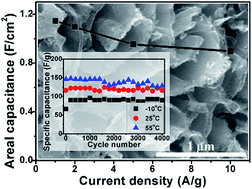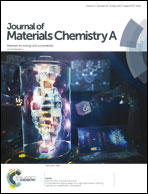Excellent performance of highly conductive porous Na-embedded carbon nanowalls for electric double-layer capacitors with a wide operating temperature range
Abstract
Porous Na-embedded carbon (Na@C), which was recently invented, possesses both very high electrical conductivity and a large accessible surface area. These unique properties can meet strict requirements for ideal electrode materials. Herein, it was revealed that symmetric electric double-layer capacitors (EDLCs) with Na@C electrodes exhibited an ultrahigh areal capacitance up to 1.14 F cm−2 at a large current density up to 10 A g−1. Furthermore, a critical issue that the enhancement of mass loading usually sacrifices the gravimetric capacitance was solved with Na@C electrodes, namely, when the mass loading of the Na@C electrode was increased from 4 to 8 mg cm−2, a negligible gravimetric capacitance drop (only 0.2 F g−1) occurred at 1 A g−1. The excellent performance remained almost unchanged with increasing temperature from −10 to 55 °C. In addition, the novel electrode exhibited excellent stability with almost 100% capacitance retention at 5 A g−1 after 4000 galvanostatic charge/discharge cycles. Na@C would be a very promising electrode material for commercial electric double-layer capacitors.



 Please wait while we load your content...
Please wait while we load your content...